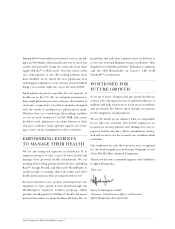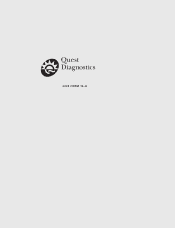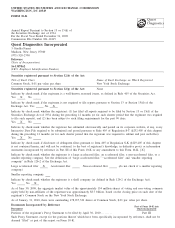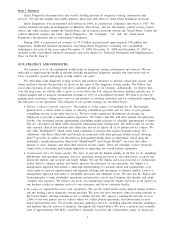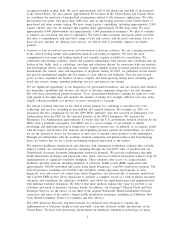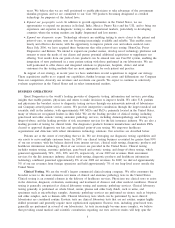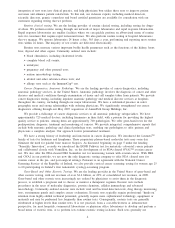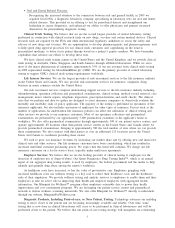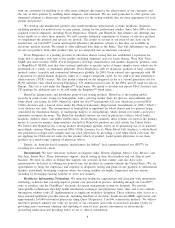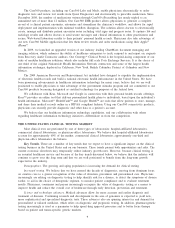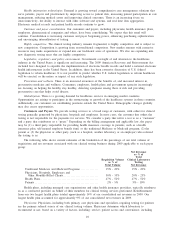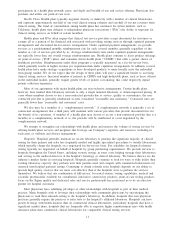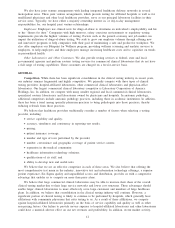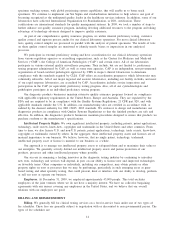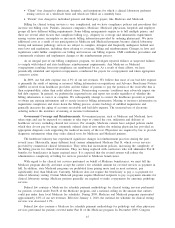Quest Diagnostics 2009 Annual Report Download - page 16
Download and view the complete annual report
Please find page 16 of the 2009 Quest Diagnostics annual report below. You can navigate through the pages in the report by either clicking on the pages listed below, or by using the keyword search tool below to find specific information within the annual report.
helping physicians assess if a woman’s ovarian mass is benign or malignant prior to a planned surgery.
This information is expected to help physicians determine whether to refer a woman with high risk of
cancer to a gynecological oncologist versus a general surgeon or gynecologist. We expect to launch the
test in the first quarter of 2010, and have a multi-year exclusive license for the clinical reference
laboratory market in the U.S.
- Our plasma-based LeumetaTM tests are useful in determining many different types of hematological
disorders, and in particular, in the diagnosis of certain hematological cancers associated with mutations
in JAK2. In 2009, we expanded our menu of Leumeta tests to add numerous tests for mutations in
multiple cancer types, including solid tumors.
•Infectious Disease.
- We continued to expand our menu of tests focused on infectious diseases, drawing on our expertise and
strength in this field.
- We introduced the first commercial test for the 2009 H1N1 influenza virus authorized by the FDA for
emergency use, approximately 12 weeks after the U.S. government declared a pandemic emergency.
Soon thereafter, the FDA granted us Emergency Use Authorization for our H1N1 influenza test to run
on our recently introduced Simplexa威testing platform. We were the first company in the U.S. that the
FDA authorized to both perform the test in its lab and also offer H1N1 test kits to high complexity
labs. This expanded the nation’s capacity to perform testing and reduce turnaround time for results. Our
H1N1 influenza test also has met the European Union’s regulatory standards and is now available to
qualified laboratories in approximately 35 countries in Europe. Our H1N1 test is a good example of our
strength in rapidly developing and deploying innovative diagnostics to improve patient care.
•Genetics and Personalized Medicine. Increasingly, tests will be introduced that determine a patient’s
genotype or gene expression profile associated with a particular disease. These tests can help physicians to
determine a patient’s susceptibility to disease or to tailor medical care to an individual’s needs – such as
determining if a medication might be more or less effective for a particular person, or which type of
medication might work better, or tailoring the right dosage once the proper medicine is prescribed. A few
examples are set forth below:
- Most of the roughly one million patients who undergo stent procedures each year are prescribed the
anti-platelet drug Plavix(clopidogrel biphosphate) to help prevent the formation of blood clots, that can
lead to heart attack or stroke. Yet, 30% or more of people possess the CYP2C19 gene, which, if
present, can slow the metabolism of clopidogrel. As a result, these patients may have a lessened
response to normal doses of clopidogrel. This information can be helpful to a physician in determining
whether to prescribe a higher dose of clopidogrel or an alternative anti-platelet drug. We introduced
AccuTypeTM CP, a gene-based test that uses a blood or saliva sample to aid the identification of this
gene to help physicians predict the metabolism of clopidogrel in patients.
- We have a leading offering of tests to aid in the care of patients with HIV. This year, we added our
HIV-1 Coreceptor Tropism Test, which aids physicians in predicting if a patient will respond to the
newest class of antiretroviral drugs, called entry inhibitors. Our test reports results in approximately half
the time of the nearest competing test, enabling physicians to more quickly determine therapeutic
choices for patients. In addition to HIV tropism testing, the Company’s test services range from HIV
diagnostic testing to monitoring HIV viral load, determining a viral genotype, and testing for the HLA-
B*5701 genetic marker as an aid in helping to predict a hypersensitivity reaction to Ziagen(abacavir),
an antiretroviral medication.
- Our ClariSureTM aCGH postnatal test was approved by the State of New York. The test employs
microarray analysis to aid in detecting copy-number chromosomal abnormalities implicated in dozens of
medical conditions, including mental retardation, birth defects and autism spectrum and developmental
disorders, which conventional laboratory tests may fail to detect.
•Cardiovascular Disease.
- In 2009, we introduced our first protein mass spectrometry test, for Aldosterone Renin Ratio. Use of the
test, which aids in the diagnosis of secondary hypertension, is supported by 2009 Endocrine Society
Consensus Guidelines. The test improves specificity and reduces turn around time compared to
competing tests.
6


